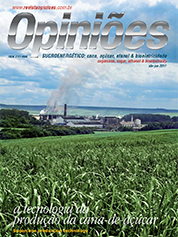William Lee Burnquist
General Manager of Ceres Sementes do Brasil
Op-AA-28
Anticipating the season
There has seen a significant evolution in all sugarcane production processes over the last thirty years. Planting, harvesting and transportation systems are much more efficient today than in the past. What about the use of by-products? Vinasse and filter cake resulting from the industrial process are returned to the fields as nutrients: an excellent example of sustainable production.
Sugarcane breeding developed by institutions such as the Centro de Tecnologia Canaviera, RIDESA and the Instituto Agronomico de Campinas has made available to producers productive varieties for many soil and climatic conditions. Despite all the progress, the industry has not yet satisfactorily solved the harmful effects of seasonal production.
It is true that now the season is longer than thirty years ago, partly due to the development of early varieties that reach reasonable values of ATR (Total Recovered Sugars) in the first months of harvest. Yet, we still have almost four months between harvests in the Central South. Among the problems caused by the existence of the off season, we highlight the high fixed cost of the industry, and the interruption of revenue for the producer.
For consumers, the seasonality of production creates an imbalance between supply and demand. Besides the need to increase the supply of ethanol to meet growing demand, there is need to balance supply during the year. Once again the sugarcane harvest this year starts with a deficit of feedstock. Last year’s weather conditions made it difficult to establish a good program for this harvest and the lack of feedstock for ethanol production boosts prices at the beginning of the year.
The industry and government study measures to balance supply of ethanol. They discuss the storage of the product and even fiscal and financial intervention policies of dubious consequences. Currently, some companies are adopting an innovative technology to anticipate the crop season, which can contribute greatly to alleviate the imbalance in the supply of ethanol. It is the use of Sweet Sorghum.
This crop has a short cycle of about 120 days, in which the stem accumulates abundant juice with high sugars content, suitable for ethanol or more advanced butanol or farnesene fermentations. CERES has evaluated many sweet sorghum hybrids in various soil and climate conditions in the country in recent years.
These hybrids, derived from crosses between sweet males and females are superior to crosses made from sweets with forage types made in the past. They have shown yield potential of 60 to 80 tons per hectare with sugar content of 120 kg per ton in the months of March and April. One likely scenario for this crop is a November seeding and March harvest, 120 days after planting. Thus, the industry can start processing the crop with sugar content higher than that of sugarcane at that time, and postpone the harvest of sugarcane for a period of greater ATR.
This practice also permits mills to use fallow “renewal areas” for planting of sweet sorghum, which will result in increased production of ethanol, without prejudice to the sugarcane area, because the same area that received the sorghum can be used for planting sugarcane, after the harvest of sorghum.
Thus the production of ethanol from sorghum does not substitute cane ethanol, quite the contrary, it adds to it, an excellent example of complementary production and efficiency in the use of production factors, resulting in significant increase in revenue growth and improved cash flow. The November to March cycle also allows greater flexibility in scheduling the harvest.
At the end of a season it is already possible to predict fairly accurately the deficit or surplus of sugarcane for the next harvest. Planting of sorghum in November may be recommended in time to address a feedstock deficit for the next crop, something impossible to do with sugarcane, due to the long cycle. In this season of 2011-2012, for example, many companies could have benefitted by planting sweet sorghum in November 2010.
The sweet sorghum production system, with the exception of seeding, uses existing agricultural equipment at the mill. Sweet sorghum harvesting is done with conventional sugarcane harvesters, and the same transport systems and logistics are also employed with sweet sorghum. In the mill, whether in mill rolls or diffusers, no changes are needed to process sweet sorghum.
The crop can therefore be classified as a “drop-in feedstock”, needing no additional investment in production and industrial processing. Being a seed propagated crop is another important advantage of sweet sorghum. One of the great frustrations of sugarcane producers is the logistics, cost and painfully slow rate of expansion of the crop. Planting 10,000 hectares of sugarcane is a nightmare. Planting 10,000 acres of sweet sorghum is a cinch. For these and other reasons we believe that many producers will look for this new technology in upcoming harvests for their brownfield or greenfield projects.




